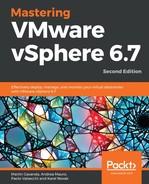Let's have a look at a comparison of standard servers. We are assuming the same configuration for every system:
- Two-socket servers, Intel Xeon 2680 v4 (14 cores)
- 512 GB RAM
- 1.6 TB NVMe SSD (maximum installable amount)
- 42U cabinet size, 2U dedicated for networking hardware
With our standard servers, we will utilize one cabinet for standard servers, and a second cabinet will be used for standard storage arrays (assuming storage nodes with 2U size and 24 SFF disks per node).
For hyper-converged servers, we will utilize a 4-node HCI configuration in a single 2U chassis (total storage capacity is 24 SFF disks for 4 nodes).
| Infrastructure type | Standard servers | Hyper-converged |
| Number of compute servers | 40 | 0 |
| Number of standard storage arrays | 20 | 0 |
| Number of hyper-converged servers | 0 | 40 |
| Number of hyper-converged nodes | 0 | 160 |
| Total CPU capacity (physical CPU cores) | 1 120 CPU cores | 2 240 CPU cores |
| Total memory capacity (installed memory size) | 20 480 GB | 40 960 GB |
| Total storage capacity (raw capacity) | 768 TB | 1 536 TB |
As you can see, with hyper-converged servers you can achieve twice as many compute resources and 50% more storage resources compared to standard servers in the same footprint.
Hyper-converged servers are usually deployed in SDDC solutions where all of the core components (compute, storage, and network) are managed by software to provide simplicity and flexibility when compared with legacy solutions.
